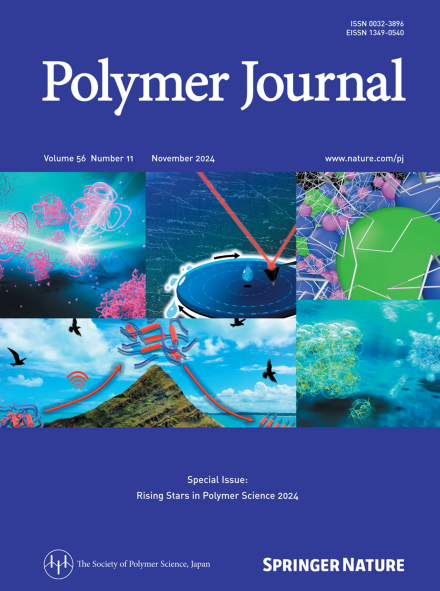Simple machine learning model for the glass transition temperatures of hydrated polymers
IF 2.7
4区 化学
Q3 POLYMER SCIENCE
引用次数: 0
Abstract
The glass transition temperature under dry conditions (Tg,dry) is an important factor for understanding the properties of polymeric materials; however, Tg,dry is often not a suitable factor for understanding the functions of biomaterials because these materials are used in water or are in contact with water. Therefore, the glass transition temperature under hydrated conditions (Tg,wet) is a crucial thermal property of polymers, particularly biomaterials. Traditional Tg,wet measurements require significant skill and are prone to error. To address this, we developed a machine learning (ML) model to predict Tg,wet from the polymer structures using a small dataset of 33 polymers. SMILES was used to generate Morgan fingerprints (MFPs) and SMILES-fragments (FLs), which serve as descriptors for the ML models. We used both random forest (RF) and ridge regression (RR) algorithms, and these algorithms were optimizing through grid search and cross-validation. The ML models using only chemical structure descriptors (MFP and FL) exhibited poor predictive performance and showed overfitting. However, when the values of Tg,dry were included as an explanatory variable, the RR model using MFP provided the best performance. These results highlight the importance of incorporating the data of Tg,dry to enhance the prediction of Tg,wet. Our model has the potential to facilitate the design of functional biomaterials. The glass transition temperature of the dry polymers (Tg,dry) is a useful parameter for predicting that of hydrated polymers (Tg,wet). By combining Tg,dry and chemical structures, simple machine learning models for Tg,wet can be constructed even with a small dataset.

水合聚合物玻璃化转变温度的简单机器学习模型
干燥条件下的玻璃化转变温度(Tg,dry)是了解聚合物材料特性的一个重要因素;然而,Tg,dry 通常并不是了解生物材料功能的合适因素,因为这些材料在水中使用或与水接触。因此,水合条件下的玻璃化转变温度(Tg,wet)是聚合物,尤其是生物材料的重要热特性。传统的湿态玻璃化转变温度测量需要大量的技术,而且容易出错。为了解决这个问题,我们开发了一种机器学习(ML)模型,利用 33 种聚合物组成的小型数据集,根据聚合物结构预测 Tg,wet。我们使用 SMILES 生成摩根指纹 (MFP) 和 SMILES 片段 (FL),作为 ML 模型的描述符。我们使用了随机森林(RF)和脊回归(RR)算法,并通过网格搜索和交叉验证对这些算法进行了优化。仅使用化学结构描述符(MFP 和 FL)的 ML 模型的预测性能较差,出现了过拟合现象。然而,当将 Tg,dry 值作为一个解释变量时,使用 MFP 的 RR 模型提供了最佳性能。这些结果凸显了加入干重值数据对提高湿重预测的重要性。我们的模型有望促进功能性生物材料的设计。干聚合物的玻璃化转变温度(Tg,dry)是预测水合聚合物玻璃化转变温度(Tg,wet)的有用参数。通过将干态玻璃化温度与化学结构相结合,即使数据集很小,也能构建出简单的湿态玻璃化温度机器学习模型。
本文章由计算机程序翻译,如有差异,请以英文原文为准。
求助全文
约1分钟内获得全文
求助全文
来源期刊

Polymer Journal
化学-高分子科学
CiteScore
5.60
自引率
7.10%
发文量
131
审稿时长
2.5 months
期刊介绍:
Polymer Journal promotes research from all aspects of polymer science from anywhere in the world and aims to provide an integrated platform for scientific communication that assists the advancement of polymer science and related fields. The journal publishes Original Articles, Notes, Short Communications and Reviews.
Subject areas and topics of particular interest within the journal''s scope include, but are not limited to, those listed below:
Polymer synthesis and reactions
Polymer structures
Physical properties of polymers
Polymer surface and interfaces
Functional polymers
Supramolecular polymers
Self-assembled materials
Biopolymers and bio-related polymer materials
Polymer engineering.
 求助内容:
求助内容: 应助结果提醒方式:
应助结果提醒方式:


